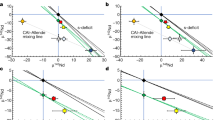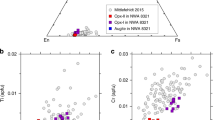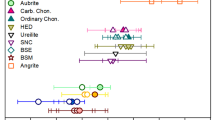Abstract
CHONDRITES are generally regarded as being the oldest objects in the Solar System. However, most of them have suffered severe secondary effects, such as metamorphism, shock and irradiation. The gas-rich polymict breccias have had the most complex history of the chondrites. Some grains of polymict breccias have been exposed to solar irradiation and trapped solar-type rare gases before compaction of the meteorite. Evidence indicates that they were formed in a regolithic environment at the surface of their parent body1. However, the timing of the successive events which affected the gas-rich chondrites is largely unnknown. Saint Mesmin (chemical group LL), is probably the best studied example2–7 of this class of meteorites. It consists of a dark matrix, rich in solar-type noble gases, which contains light gas-poor xenoliths2. The matrix is mineralogically unequilibrated and its material belongs to the chondritic petrological types 4 and 5 (ref. 3). In contrast the xenoliths have been strongly metamorphosed and re-equilibrated and belong to the petrological types 6 and 7 (ref. 3). Also veins of olivine microporphyry run across the meteorite3. Finally, a technically incorporated piece of chondrite, of the chemical group H (type H4), has been found in Saint Mesmin4. Here, we deal with 87Rb–87 Sr dating of small 10 mg, hand-picked pieces, of the various components of Saint Mesmin. These pieces have been studied by the other techniques3–7 and have been named by Pellas. Light xenoliths are labelled LI to L8 and dark samples Dl to D8. One particular light xenolith of petrological type 7 is named C3. Two samples of the type H4 xenolith are named Dl and DD respectively. Where several pieces of the same sample had been analysed independently, we added a second digit to the sample name (for example L81 and L82). We have also analysed heavy liquid fractions of one light xenolith (L6) and of one sample of the H4 type xenolith (DD).
This is a preview of subscription content, access via your institution
Access options
Subscribe to this journal
Receive 51 print issues and online access
$199.00 per year
only $3.90 per issue
Buy this article
- Purchase on Springer Link
- Instant access to full article PDF
Prices may be subject to local taxes which are calculated during checkout
Similar content being viewed by others
References
Rajan, R. S., Huneke, J. C., Smith, S. P. & Wasserburg, G. J. Earth planet. Sci. Lett. 27, 181–190 (1975).
Heymann, D. & Mazor, E. J. geophys. Res. 71, 4695–4697 (1966).
Dodd, R. T. Contr. Miner. Petrol. 46, 129–147 (1974).
Pellas, P. in From Plasma to Planet (ed. Alvius, A.) 65–92 (Wiley, New York, 1973).
Ducatel, R. T. & Poupeau, G. Meteoritics 9, 336 (1974).
Dodd, R. T. and Jarosevitch, E. Meteoritics 11, 1–21 (1976).
Schultz, L. & Signer, P. Earth planet. Sci. Lett. 36, 363–371 (1977).
Birck, J. L. & Allegre, C. J. Earth planet. Sci. Lett. 26, 29–35 (1973); 39, 37–51 (1978).
Minster, J. F. & Allegre, C. J. Earth planet. Sci. Lett. 32, 191–198 (1976); 42, 333–347 (1979).
Gopalan, K. & Wetherill, G. W. J. geophys. Res. 74, 4349–4358 (1969).
Gopalan, K. & Wetherill, G. W. J. geophys. Res. 76, 8484–8492 (1971).
Cadogan, P. H. & Turner, G. Meteoritics 10, 375–376 (1975).
Kempe, W. & Muller, O. in Meteorite Research (ed. Millman, P.) 418–428 (Reidel,Dordrecht, 1969).
Gray, C. M., Papanastassiou, D. A. & Wasserburg, G. J. Icarus 20, 213–239 (1973).
Author information
Authors and Affiliations
Rights and permissions
About this article
Cite this article
MINSTER, J., ALLEGRE, C. 87Rb–87Sr age of Saint Mesmin chondrite and dating of gas-rich polymict breccia. Nature 278, 732–734 (1979). https://doi.org/10.1038/278732a0
Received:
Accepted:
Published:
Issue Date:
DOI: https://doi.org/10.1038/278732a0
This article is cited by
Comments
By submitting a comment you agree to abide by our Terms and Community Guidelines. If you find something abusive or that does not comply with our terms or guidelines please flag it as inappropriate.



